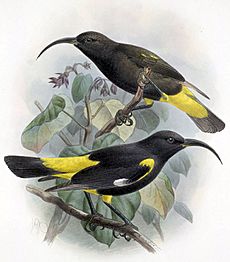Hawaii mamo facts for kids
Quick facts for kids Hawaiʻi mamo |
|
|---|---|
 |
|
| Specimen | |
| Conservation status | |
| Scientific classification | |
| Genus: |
Drepanis
|
| Species: |
pacifica
|
The Hawaiʻi mamo (Drepanis pacifica) was a special type of Hawaiian honeycreeper bird. It lived only on the island of Hawaiʻi. Sadly, this beautiful bird is now extinct. It disappeared because its home was destroyed, and new animals like mosquitoes and mongooses arrived. People also collected too many of these birds.
Contents
What the Hawaiʻi Mamo Looked Like
The Hawaiʻi mamo was about 9 inches (23 cm) long. Most of its body was black. But it had bright yellow feathers on its bottom, under its tail, on its shoulders, and on its legs. There was also a white patch on its main wing feathers.
This bird had small, black eyes. Its bill was slightly curved and blackish, about three inches long. Young mamo birds might have been brown. This shy bird lived high up in the forest trees. It ate nectar from the curved, tube-shaped flowers of lobelia plants. Its call was a long, sad whistle.
The Mamo in Hawaiian Culture
The mamo was a very important bird in ancient Hawaii. Its bright yellow feathers were used to make special capes and hats for royalty. These beautiful feather items were called featherwork.
Collecting these feathers was one reason the bird's numbers went down. For example, the famous yellow cloak of Kamehameha I was huge. It is thought to have taken eight kings' lifetimes to make. It also needed feathers from about 80,000 mamo birds!
Hawaiians had a clever way to catch the birds. They would take sticky sap from sandalwood and breadfruit trees. They put this sap near the lobelia flowers. When a hungry mamo came to drink nectar, its feet would get stuck in the sap.
Some people believe that after taking the feathers, the mamo birds were kept as pets or cooked. However, others say there was a special rule called a Kapu. This rule meant the birds had to be set free after their feathers were collected. Even if the birds were released, they might have been shocked or hurt. But Hawaiian birds are often quite calm when caught. So, they might have survived being handled better than other birds.
Why the Mamo Disappeared
European settlers also liked to collect these birds. This added to the problem of too many birds being taken from the wild.
The settlers also changed the mamo's home. They cleared forests for farming and raising cattle. This destroyed the plants the mamo birds ate. The cattle roamed freely in the forests. They ruined the smaller plants and ecosystem on the forest floor. Even though Hawaiians knew this was happening, the mamo birds quickly started to disappear.
New diseases brought by settlers might have killed any birds that survived the habitat loss. Today, many museums in America and Europe have specimens of the Hawaiʻi mamo.
The bird seemed to vanish around 1899. However, there were a few more reports of sightings for some years. The last confirmed sighting was in July 1898. A collector named Henry W. Henshaw saw the bird near Kaumana on the island of Hawaiʻi. He shot and wounded a bird he was following, but it got away with another bird. The very last bird was shot in 1898.
See also
 In Spanish: Mamo hawaiano para niños
In Spanish: Mamo hawaiano para niños



